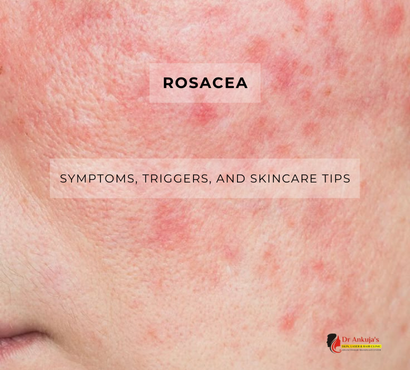Rosacea is a chronic skin condition that causes redness, visible blood vessels, and bumps on the face. It is often mistaken for acne, an allergic reaction, or sunburn, but rosacea has its own distinct triggers and symptoms. While there is no permanent cure, proper skincare, trigger management, and medical treatment can help control symptoms effectively.
In this guide, we will explore the symptoms of rosacea, common triggers that worsen the condition, and essential skincare tips to manage it better.
Understanding Rosacea: What Is It?
Rosacea is a long-term inflammatory skin condition that primarily affects the face. It is more common in fair-skinned individuals, but people of all skin tones can develop it. It often worsens over time if left untreated, leading to persistent redness, enlarged blood vessels, and skin thickening in severe cases.
Rosacea typically appears between the ages of 30 and 50 and is more common in women than men. However, men tend to experience more severe symptoms.
Symptoms of Rosacea
Rosacea symptoms can vary from person to person, but the most common ones include:
1. Facial Redness (Erythema)
✔ Persistent redness on the cheeks, nose, forehead, or chin.
✔ Skin may appear flushed or sunburned.
2. Visible Blood Vessels (Telangiectasia)
✔ Small, broken blood vessels become noticeable on the face.
✔ Often worsens with time if not managed properly.
3. Bumps and Pimples (Papulopustular Rosacea)
✔ Red, acne-like bumps that may contain pus.
✔ Unlike acne, rosacea does not cause blackheads.
4. Burning or Stinging Sensation
✔ Skin feels hot, sensitive, or irritated.
✔ May worsen with spicy foods, hot drinks, or sun exposure.
5. Eye Irritation (Ocular Rosacea)
✔ Eyes become dry, red, watery, or irritated.
✔ Eyelids may swell, leading to blurry vision.
6. Skin Thickening (Phymatous Rosacea)
✔ In severe cases, the skin—especially on the nose—thickens, leading to a bulbous appearance (rhinophyma).
✔ More common in men than women.
🚨 When to See a Doctor?
- If you notice persistent facial redness or bumps that don’t go away.
- If your eyes become red, irritated, or swollen.
- If your symptoms are interfering with your confidence or daily life.
Common Triggers That Worsen Rosacea
Several factors can trigger or worsen rosacea flare-ups. Identifying and avoiding these triggers is crucial for managing the condition.
1. Sun Exposure ☀
- The most common trigger for rosacea.
- Even a few minutes in the sun can cause flare-ups.
✔ Tip: Always wear broad-spectrum sunscreen (SPF 30+), even on cloudy days.
2. Spicy Foods & Hot Drinks 🌶☕
- Spicy foods and hot beverages like tea, coffee, and soup can increase facial flushing.
✔ Tip: Opt for mild flavors and lukewarm drinks.
3. Alcohol Consumption 🍷
- Alcohol—especially red wine, beer, and hard liquor—can cause blood vessels to dilate, worsening redness.
✔ Tip: Limit or avoid alcoholic beverages, particularly red wine.
4. Temperature Extremes ❄🔥
- Both hot and cold weather can aggravate rosacea.
✔ Tip: In cold weather, wear a scarf, and in hot weather, stay indoors during peak sun hours.
5. Stress & Anxiety 😟
- Emotional stress is a major trigger for many rosacea patients.
✔ Tip: Practice stress management techniques like yoga, meditation, and deep breathing exercises.
Skincare Tips for Managing Rosacea
A proper skincare routine plays a significant role in reducing rosacea flare-ups. Here are some dermatologist-approved tips:
1. Use a Gentle Cleanser 🧼
- Choose a mild, fragrance-free, and sulfate-free cleanser.
- Avoid scrubbing your face, as it can cause irritation.
2. Moisturize Daily 💧
- Keeping your skin hydrated can strengthen the skin barrier.
- Look for hypoallergenic, non-comedogenic, and ceramide-rich moisturizers.
3. Always Wear Sunscreen ☀
- UV rays can worsen rosacea symptoms, even on cloudy days.
- Use a broad-spectrum SPF 30+ sunscreen with zinc oxide or titanium dioxide.
4. Avoid Harsh Ingredients 🚫
- Stay away from alcohol-based toners, astringents, exfoliants, and retinoids.
- Avoid menthol, eucalyptus, and camphor, as they can trigger flare-ups.
5. Opt for Rosacea-Friendly Makeup 💄
- Choose mineral-based foundations that don’t clog pores.
- Green-tinted primers can help neutralize redness.
6. Treat Ocular Rosacea with Eyecare 👀
- If your eyes are affected, use preservative-free artificial tears.
- Clean your eyelids daily with a warm washcloth.
7. Consider Medical Treatments 💉
If rosacea symptoms are severe, a dermatologist may recommend:
✔ Topical medications like metronidazole or azelaic acid.
✔ Oral antibiotics (for inflammatory rosacea).
✔ Laser therapy to reduce visible blood vessels.
Rosacea may be chronic, but with the right skincare, trigger management, and medical treatments, symptoms can be significantly reduced. Understanding what triggers your rosacea and following a gentle skincare routine are key steps in controlling flare-ups and maintaining healthy skin. If you experience persistent redness, burning, or eye irritation, consult a dermatologist for personalized treatment options.
✨ Healthy skin starts with awareness—take care of your skin today!
FAQs
1. Can rosacea be permanently cured?
No, rosacea is a chronic condition, but it can be effectively managed with lifestyle changes, skincare, and medical treatments.
2. Is rosacea the same as acne?
No, while both conditions cause bumps, rosacea does not have blackheads and is triggered by different factors like sun exposure and stress.
3. What is the best diet for rosacea?
A rosacea-friendly diet includes anti-inflammatory foods like leafy greens, fish, whole grains, and probiotics, while avoiding spicy foods, alcohol, and caffeine.

